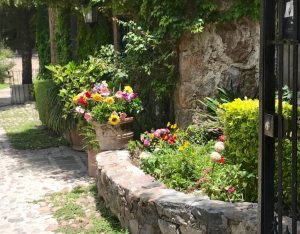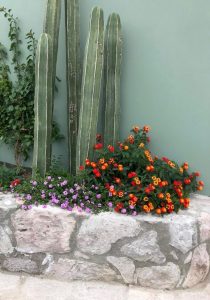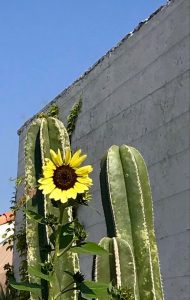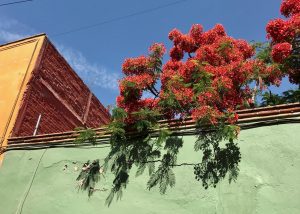“Juxtaposition!” the graduate student instructor cried, slapping his flat hand on the classroom’s front desk. “Jux – ta – po – si –tion! Now that’s a college-level word for you. Be sure to use it!”
I was awe-struck. In my first semester at Columbia in New York as a full-scholarship student, almost everything and everyone I encountered left me in open-mouthed awe. I sometimes thought I’d died, passed through the Pearly Gates (Columbia’s gigantic iron front gates on Broadway and 116th Street), and entered a gleamingly bright, ethereal, intellectual heaven.
I thrilled at the solid old buildings with their marble staircases worn down by countless students’ shoes, the professors with their esoteric specialties and their messianic drive to share their knowledge, my earnest classmates discussing the protagonists of novels the way surgeons might discuss their best cases. As Little Ms. Nobody from Nowheresville, New Jersey, I couldn’t believe my good fortune.
I had to ask myself in that moment: Had I ever used the word juxtaposition in my life? (Answer: No.) Did I even know what it meant, exactly? I had to look it up, to make sure: “…the act or an instance of placing two or more things side by side, often to compare or contrast or to create an interesting effect.” The word, I learned, came from the blending of the Latin “juxta,” meaning “next,” and the French word “position.”
This memory — this delicious big mouthful of a word — has come back to me recently on my daily walks throughout this beautiful little old Mexican city of San Miguel de Allende, where the brand new often resides side-by-side with the very old. Colorful, delicate, living flowers abut buff-colored, rough, inert stone walls at every turn. On the sidewalks pretty teenage Mexican girls in deliberately ripped jeans stride past bent old women in traditional indigenous costumes.
The many contrasts here – the vivid colors and varied textures, the hot sunshine and cool shadows, the extremes of wealth and poverty — are eye-popping and thought-provoking, I find. There are sermons in such snapshots for me.
It’s natural, I think, to compare and contrast, to look for the juxtapositions in our personal lives. And then, like an artist might, I think it’s helpful to employ it all – the dark with the light, the rough with the smooth. These contrasts help to create the dramatic, artistic effects that deepen meaning and understanding.
I’m reminded of this short stanza in Ric Masten’s poem “Let It Be a Dance”:
The morning star comes out at night.
Without the dark, there’d be no light.
Yet, if nothing’s wrong, then nothing’s right.
So, let it be a dance.
Here are just a handful of my photos of San Miguel’s lovely juxtapositions taken on recent walks:






Wonderful essay. Thank you. (I live here in SMA also)
Thank you, Cynthia! So glad you liked it. Please share it, if you can.
Lovely. Thoughtful.
Thank you, dear Lyn!
Thanks for the reminder of how beauty is all around us if we just look with open eyes
Thank YOU, Nuala, for commenting. Every day on my long walks I thank God for legs that still walk and eyes that still see the beauty all around me here.
Loved this essay, Bonnie. And for me, just recently, I realized I was seeing things, even the familiar, anew and with happy notations on my walks. Must be the reopening in us all after the long closure of the pandemic year. The juxtaposition of 2020 with 2021
Thank you, dear Theresa. Yes, the juxtaposition of this year with last! What a contrast.
Missing San Miguel and it’s,people, including Bonnie Lee Black! Moved to ABQ in may to be near family Abrazos
I and all of SMA miss you, too, dear Pat! Sending you love and hugs, BB xx
Thank you Bonnie. A post which made me think that life also reconciles the highs and lows, the not so perfect with the excellent. Great post.
Thank you, Trudi! Yes, “reconcile” is such a good word here — to coexist in harmony. Something to aspire to!
Ah, so much beauty and color. And I love these Sunday words 🙂
Thank you, querida Te! I look forward to the day when you’ll see all this beauty and color in person here.
Dear Bon,
What beautiful pictures! You make such wonderful connections among all the sights you discover in your path. It’s that writer’s eye, always observing and thinking. Thanks for another thoughtful post.
Love,
Paul
Thank you, dearest Paul. Your comments always lift my spirits. Hope you’re doing well. Abrazos (hugs), BB xx
BonnieDear, this made me think of our many walks together when you lived in Taos. And of something I heard you say more than once after I complimented you on a particular observation: “A writer is one on whom nothing is lost.” Obviously, this is still true! xoxo~be
Ah, Be, I think that’s another item I picked up in the writing program at Columbia! Things like this tend to stick when we’re young and impressionable! 🙂
Lovely!
Thank you so much, Lily!
What a beautiful town of flowers, colors and textures, juxtaposed with its hardscrabble neighborhoods.
Thanks, Steve! So true: juxtaposed.